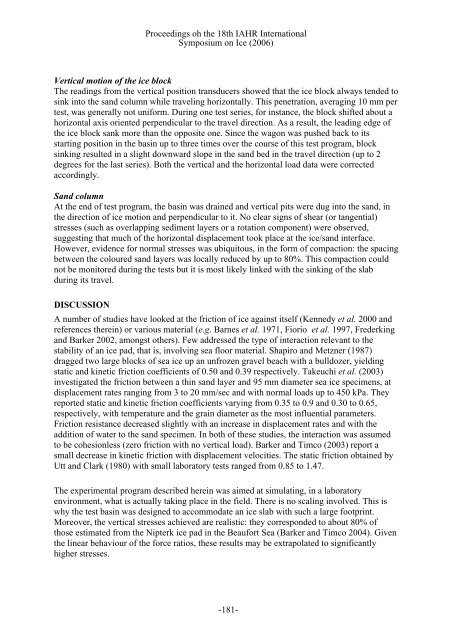ice pad stability on sand: large-scale laboratory tests
ice pad stability on sand: large-scale laboratory tests
ice pad stability on sand: large-scale laboratory tests
You also want an ePaper? Increase the reach of your titles
YUMPU automatically turns print PDFs into web optimized ePapers that Google loves.
Proceedings oh the 18th IAHR Internati<strong>on</strong>alSymposium <strong>on</strong> Ice (2006)Vertical moti<strong>on</strong> of the <str<strong>on</strong>g>ice</str<strong>on</strong>g> blockThe readings from the vertical positi<strong>on</strong> transducers showed that the <str<strong>on</strong>g>ice</str<strong>on</strong>g> block always tended tosink into the <strong>sand</strong> column while traveling horiz<strong>on</strong>tally. This penetrati<strong>on</strong>, averaging 10 mm pertest, was generally not uniform. During <strong>on</strong>e test series, for instance, the block shifted about ahoriz<strong>on</strong>tal axis oriented perpendicular to the travel directi<strong>on</strong>. As a result, the leading edge ofthe <str<strong>on</strong>g>ice</str<strong>on</strong>g> block sank more than the opposite <strong>on</strong>e. Since the wag<strong>on</strong> was pushed back to itsstarting positi<strong>on</strong> in the basin up to three times over the course of this test program, blocksinking resulted in a slight downward slope in the <strong>sand</strong> bed in the travel directi<strong>on</strong> (up to 2degrees for the last series). Both the vertical and the horiz<strong>on</strong>tal load data were correctedaccordingly.Sand columnAt the end of test program, the basin was drained and vertical pits were dug into the <strong>sand</strong>, inthe directi<strong>on</strong> of <str<strong>on</strong>g>ice</str<strong>on</strong>g> moti<strong>on</strong> and perpendicular to it. No clear signs of shear (or tangential)stresses (such as overlapping sediment layers or a rotati<strong>on</strong> comp<strong>on</strong>ent) were observed,suggesting that much of the horiz<strong>on</strong>tal displacement took place at the <str<strong>on</strong>g>ice</str<strong>on</strong>g>/<strong>sand</strong> interface.However, evidence for normal stresses was ubiqu itous, in the form of compacti<strong>on</strong>: the spacingbetween the coloured <strong>sand</strong> layers was locally reduced by up to 80%. This compacti<strong>on</strong> couldnot be m<strong>on</strong>itored during the <strong>tests</strong> but it is most li kely linked with the sinking of the slabduring its travel.DISCUSSIONA number of studies have looked at the fricti<strong>on</strong> of <str<strong>on</strong>g>ice</str<strong>on</strong>g> against itself (Kennedy et al. 2000 andreferences therein) or various material (e.g. Barn es et al. 1971, Fiorio et al. 1997, Frederkingand Barker 2002, am<strong>on</strong>gst others). Few addressed the type of interacti<strong>on</strong> relevant to the<str<strong>on</strong>g>stability</str<strong>on</strong>g> of an <str<strong>on</strong>g>ice</str<strong>on</strong>g> <str<strong>on</strong>g>pad</str<strong>on</strong>g>, that is, involving sea floor material. Shapiro and Metzner (1987)dragged two <strong>large</strong> blocks of sea <str<strong>on</strong>g>ice</str<strong>on</strong>g> up an unfrozen gravel beach with a bulldozer, yieldingstatic and kinetic fricti<strong>on</strong> coefficients of 0.50 and 0.39 respectively. Takeuchi et al. (2003)investigated the fricti<strong>on</strong> between a thin <strong>sand</strong> layer and 95 mm diameter sea <str<strong>on</strong>g>ice</str<strong>on</strong>g> specimens, atdisplacement rates ranging from 3 to 20 mm/sec and with normal loads up to 450 kPa. Theyreported static and kinetic fricti<strong>on</strong> coefficients varying from 0.35 to 0.9 and 0.30 to 0.65,respectively, with temperature and the grain diameter as the most influential parameters.Fricti<strong>on</strong> resistance decreased slightly with an increase in displacement rates and with theadditi<strong>on</strong> of water to the <strong>sand</strong> specimen. In both of these studies, the interacti<strong>on</strong> was assumedto be cohesi<strong>on</strong>less (zero fricti<strong>on</strong> with no vertical load). Barker and Timco (2003) report asmall decrease in kinetic fricti<strong>on</strong> with displacement velocities. The static fricti<strong>on</strong> obtained byUtt and Clark (1980) with small <strong>laboratory</strong> <strong>tests</strong> ranged from 0.85 to 1.47.The experimental program described herein was aimed at simulating, in a <strong>laboratory</strong>envir<strong>on</strong>ment, what is actually taking place in the field. There is no scaling involved. This iswhy the test basin was designed to accommodate an <str<strong>on</strong>g>ice</str<strong>on</strong>g> slab with such a <strong>large</strong> footprint.Moreover, the vertical stresses achieved are realistic: they corresp<strong>on</strong>ded to about 80% ofthose estimated from the Nipterk <str<strong>on</strong>g>ice</str<strong>on</strong>g> <str<strong>on</strong>g>pad</str<strong>on</strong>g> in the Beaufort Sea (Barker and Timco 2004). Giventhe linear behaviour of the force ratios, these results may be extrapolated to significantlyhigher stresses.-181-
















